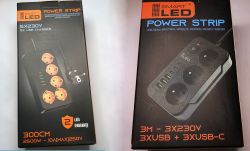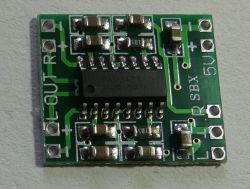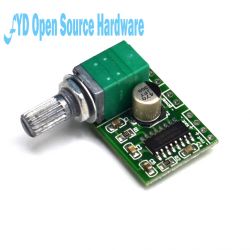The PAM8403 amplifier, as described on the auction site, works in class D, which suggests energy saving, while the 5V power supply and 2x3W power allows it to be powered from e.g. a power bank. You can find the modules by searching for the phrase in stores and auction portals PAM8403 . 2x3W power should be sufficient for small portable audio devices.
After connecting 8 Ohm 10W speakers and powering the system, there was a low noise in the speakers (despite the lack of an input signal). Without connected speakers, the system consumed 5mA, after connecting 8om speakers, the power consumption increased to 13mA (without input signal). The listening test was successful, the sound was acceptable, but slightly different than from the "analog" amplifier in the AB class.
My musical hearing is rather digital (I recognize when there is or no music ), and the subject of audio is foreign to me, I focused on the performance and properties of the PAM8403. I envisioned the class D amplifier as a properly controlled "buck converter" and was surprised by the lack of inductance on the amplifier module board. I count on comments and suggestions from people dealing with audio topics.
), and the subject of audio is foreign to me, I focused on the performance and properties of the PAM8403. I envisioned the class D amplifier as a properly controlled "buck converter" and was surprised by the lack of inductance on the amplifier module board. I count on comments and suggestions from people dealing with audio topics.
Instead of speakers, I connected 8om resistors and here is a big surprise, power consumption increased to 132mA!
Connecting the 4om resistors resulted in a current consumption of 152mA.
Apparently, loudspeaker inductance plays an important role in the performance of an amplifier.
Ultimately, the tests took place after connecting 4om resistors to the amplifier output.

After checking with an oscilloscope what is happening at the output of the amplifier in the absence of a signal, it was explained why there is low noise in the speakers. A waveform with a frequency of several hundred kHz is visible.
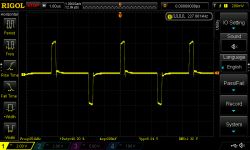
We feed the input of the amplifier with a sinusoidal signal 1kHz 100mVpp, the output is a modulated waveform of high frequency:
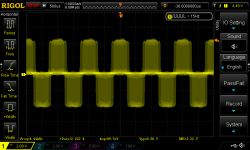

Connecting a loudspeaker instead of a resistor changes the shape of the output waveform:

The subject of audio is strange to me, but this is not how I imagined the operation of a high-efficiency amplifier. Does every class D amplifier produce such "chaff" at the output? Does PAM8403 work in class D?
Let's compare the operating characteristics of the PAM8403 with another class D amplifier TDA8932 .
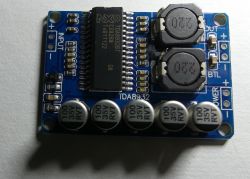
The first attempt, the module with TDA8932, in the absence of an input signal, consumes 46mA invariably, regardless of whether the output is connected to a loudspeaker 8om or a resistor 8om or 4om. The inductances are visible on the PCB.
Let's give the sine at the input and at the output we get the expected sine wave instead of the "chaff":

The trial with TDA8932 brought me out of the shock of PAM8403 :)
TDA8932 was powered by 15V, drawing 0.852A at an output voltage of 9.40V at a resistance of 8ohm (simulating a loudspeaker). 1kHz sine wave at the input.
You can estimate the power supplied to the amplifier: ~ 12.78W, the output is ~ 11.05W i.e. efficiency ~ 86% .
We return to PAM8403 with a similar test and 5V power supply connected with 4ohm resistors. The results will probably be distorted as the amplifier expects a loudspeaker to be connected, but let's see what we get. In addition, it is difficult to say what measurement error will be introduced by the multimeter, with such "chaff" at the output of the RMS amplifier may not work properly.
With an output voltage of 1V, we get 2x0.25W, i.e. a total output power of 0.5W,
the supplied power per input is 5V * 0.327A = 1.635W, which gives an efficiency of ~ 30%.
With an output voltage of 2V, we get a total output power of 2W,
the supplied power to the input is 5V * 0.711A = 3.555W, which is ~ 56% efficiency, the system is warm.
With an output voltage of 3V, we get a total output power of 4.5W,
the supplied power to the input is 5V * 1.273A = 6.365W which gives the efficiency ~ 71%, the system is very warm.
When we exaggerate with the amplitude of the input signal, we get the following waveform at the output and probably quite a lot of distortion:
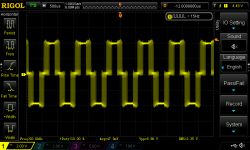
When comparing PAM8403 with TDA8932, the output waveforms and the behavior of the circuit are different. The price of PAM8403 modules is low and perhaps in simple devices with speakers such an amplifier is sufficient. The sound obtained from the PAM8403 is acceptable (for me) and in many devices it will be a good solution.
What do you think about the PAM8403 amplifier, hit or kit?
A request for feedback from people knowledgeable in audio issues and having appropriate hearing (if they had the opportunity to listen to the effects of similar amplifiers).
After connecting 8 Ohm 10W speakers and powering the system, there was a low noise in the speakers (despite the lack of an input signal). Without connected speakers, the system consumed 5mA, after connecting 8om speakers, the power consumption increased to 13mA (without input signal). The listening test was successful, the sound was acceptable, but slightly different than from the "analog" amplifier in the AB class.
My musical hearing is rather digital (I recognize when there is or no music
Instead of speakers, I connected 8om resistors and here is a big surprise, power consumption increased to 132mA!
Connecting the 4om resistors resulted in a current consumption of 152mA.
Apparently, loudspeaker inductance plays an important role in the performance of an amplifier.
Ultimately, the tests took place after connecting 4om resistors to the amplifier output.

After checking with an oscilloscope what is happening at the output of the amplifier in the absence of a signal, it was explained why there is low noise in the speakers. A waveform with a frequency of several hundred kHz is visible.

We feed the input of the amplifier with a sinusoidal signal 1kHz 100mVpp, the output is a modulated waveform of high frequency:


Connecting a loudspeaker instead of a resistor changes the shape of the output waveform:

The subject of audio is strange to me, but this is not how I imagined the operation of a high-efficiency amplifier. Does every class D amplifier produce such "chaff" at the output? Does PAM8403 work in class D?
Let's compare the operating characteristics of the PAM8403 with another class D amplifier TDA8932 .

The first attempt, the module with TDA8932, in the absence of an input signal, consumes 46mA invariably, regardless of whether the output is connected to a loudspeaker 8om or a resistor 8om or 4om. The inductances are visible on the PCB.
Let's give the sine at the input and at the output we get the expected sine wave instead of the "chaff":

The trial with TDA8932 brought me out of the shock of PAM8403 :)
TDA8932 was powered by 15V, drawing 0.852A at an output voltage of 9.40V at a resistance of 8ohm (simulating a loudspeaker). 1kHz sine wave at the input.
You can estimate the power supplied to the amplifier: ~ 12.78W, the output is ~ 11.05W i.e. efficiency ~ 86% .
We return to PAM8403 with a similar test and 5V power supply connected with 4ohm resistors. The results will probably be distorted as the amplifier expects a loudspeaker to be connected, but let's see what we get. In addition, it is difficult to say what measurement error will be introduced by the multimeter, with such "chaff" at the output of the RMS amplifier may not work properly.
With an output voltage of 1V, we get 2x0.25W, i.e. a total output power of 0.5W,
the supplied power per input is 5V * 0.327A = 1.635W, which gives an efficiency of ~ 30%.
With an output voltage of 2V, we get a total output power of 2W,
the supplied power to the input is 5V * 0.711A = 3.555W, which is ~ 56% efficiency, the system is warm.
With an output voltage of 3V, we get a total output power of 4.5W,
the supplied power to the input is 5V * 1.273A = 6.365W which gives the efficiency ~ 71%, the system is very warm.
When we exaggerate with the amplitude of the input signal, we get the following waveform at the output and probably quite a lot of distortion:

When comparing PAM8403 with TDA8932, the output waveforms and the behavior of the circuit are different. The price of PAM8403 modules is low and perhaps in simple devices with speakers such an amplifier is sufficient. The sound obtained from the PAM8403 is acceptable (for me) and in many devices it will be a good solution.
What do you think about the PAM8403 amplifier, hit or kit?
A request for feedback from people knowledgeable in audio issues and having appropriate hearing (if they had the opportunity to listen to the effects of similar amplifiers).
Cool? Ranking DIY



